The Impact of COVID-19 on Electricity Demand and Generation in Japan
Abstract
:1. Introduction
2. Background and Literature Review
3. Materials and Methods
4. Results
4.1. Electricity Generation Results
4.2. Electricity Demand Results
4.2.1. Low Voltage Results
4.2.2. High Voltage Results
4.2.3. Extra-High Voltage Results
4.3. Demand Total Results
5. Discussion
6. Conclusions
Author Contributions
Funding
Institutional Review Board Statement
Informed Consent Statement
Data Availability Statement
Conflicts of Interest
Appendix A
| Test | Explanation | Excel Script/Function |
|---|---|---|
| Seasonality | Data assessment to identify the length of any repetitive patterns within the historical data. | FORECAST.ETS.SEASONALITY(Known Historical Values, Known Historical Timeline, No missing or unknown datapoints -0-) |
| Predicted Monthly Demand | Likely future value based on an exponential smoothing algorithm. | FORECAST.ETS(Forecast Month, Known Historical Values, Known Historical Timeline, Seasonality Result) |
| Confidence Interval of Predicted Monthly Demand | 95% of possible points are expected to fall within the range calculated. | FORECAST.ETS.CONFINT(Forecast Month, Known Historical Values, Known Historical Timeline, 95% certainty, No missing or unknown datapoints -0-) |
| Assessment | Assesses if the actual value is inside or outside the range predicted by the forecast confidence interval. | IF(AND(actual value<(predicted value + confidence interval),actual value>(predicted value-confidence interval)),”in range”, “out of range”) |
| Hydro Generation | Thermal Generation | Nuclear Generation | Renewable Generation | Total Generation | |||
|---|---|---|---|---|---|---|---|
| Jan-20 | Actual | GWh | 6084 | 69,228 | 4923 | 5863 | 111,171 |
| Predicted | GWh | 5840 | 72,245 | 6407 | 6613 | 114,506 | |
| Conf. Int. | +/− GWh | 1841 | 4925 | 1317 | 752 | 9215 | |
| Feb-20 | Actual | GWh | 6290 | 63,304 | 5087 | 6653 | 105,006 |
| Predicted | GWh | 5045 | 65,266 | 6617 | 6781 | 113,224 | |
| Conf. Int. | +/− GWh | 1841 | 4925 | 1358 | 776 | 9289 | |
| Mar-20 | Actual | GWh | 7106 | 59,084 | 5132 | 8085 | 102,449 |
| Predicted | GWh | 6903 | 60,693 | 6607 | 7908 | 107,419 | |
| Conf. Int. | +/− GWh | 1841 | 4925 | 1398 | 799 | 9363 | |
| Apr-20 | Actual | GWh | 8574 | 47,889 | 4632 | 9893 | 91,640 |
| Predicted | GWh | 8632 | 46,749 | 6253 | 9014 | 100,956 | |
| Conf. Int. | +/− GWh | 1841 | 4925 | 1437 | 822 | 9439 | |
| May-20 | Actual | GWh | 8946 | 42,152 | 4518 | 10,388 | 85,613 |
| Predicted | GWh | 9632 | 45,228 | 5978 | 9605 | 102,193 | |
| Conf. Int. | +/− GWh | 1841 | 4925 | 1476 | 844 | 9514 | |
| Jun-20 | Actual | GWh | 8675 | 50,335 | 3941 | 9341 | 95,739 |
| Predicted | GWh | 7268 | 49,026 | 6216 | 8972 | 107,067 | |
| Conf. Int. | +/− GWh | 1841 | 4925 | 1514 | 865 | 9591 |
| 50 Hz | 60 Hz | TOTAL | ||||||||||
|---|---|---|---|---|---|---|---|---|---|---|---|---|
| Hokkaido | Tohoku | Kanto | Chubu | Kansai | Chugoku | Shikoku | Kyushu | Okinawa | ||||
| Jan-20 | Actual | GWh | 1646 | 2608 | 10,270 | 6152 | 6041 | 2221 | 1194 | 3552 | 355 | 34,039 |
| Predicted | GWh | 1659 | 2491 | 10,462 | 6456 | 6145 | 2263 | 1206 | 3681 | 338 | 34,702 | |
| Conf. Int. | +/− GWh | 70 | 200 | 915 | 486 | 465 | 149 | 78 | 321 | 42 | 2725 | |
| Feb-20 | Actual | GWh | 1424 | 2267 | 9858 | 5466 | 5180 | 2041 | 989 | 3070 | 296 | 30,592 |
| Predicted | GWh | 1368 | 2220 | 10,331 | 6043 | 5773 | 2237 | 1112 | 3429 | 302 | 32,816 | |
| Conf. Int. | +/− GWh | 70 | 267 | 922 | 538 | 469 | 164 | 85 | 327 | 42 | 2883 | |
| Mar-20 | Actual | GWh | 1290 | 2155 | 8510 | 5050 | 4914 | 1835 | 975 | 2902 | 296 | 27,926 |
| Predicted | GWh | 1290 | 2075 | 8816 | 5165 | 4942 | 1838 | 978 | 2950 | 286 | 28,340 | |
| Conf. Int. | +/− GWh | 70 | 320 | 929 | 579 | 472 | 177 | 92 | 333 | 42 | 3015 | |
| Apr-20 | Actual | GWh | 1128 | 2035 | 8346 | 4756 | 4347 | 1677 | 855 | 2683 | 308 | 26,135 |
| Predicted | GWh | 1088 | 1762 | 7230 | 4507 | 4341 | 1633 | 818 | 2573 | 308 | 24,259 | |
| Conf. Int. | +/− GWh | 70 | 365 | 936 | 615 | 476 | 190 | 99 | 339 | 42 | 3132 | |
| May-20 | Actual | GWh | 1082 | 1687 | 6669 | 4100 | 3997 | 1437 | 797 | 2443 | 315 | 22,527 |
| Predicted | GWh | 993 | 1445 | 6295 | 3658 | 3593 | 1295 | 734 | 2208 | 308 | 20,531 | |
| Conf. Int. | +/− GWh | 70 | 406 | 943 | 647 | 479 | 202 | 104 | 345 | 42 | 3238 | |
| Jun-20 | Actual | GWh | 754 | 1376 | 6430 | 3324 | 3302 | 1217 | 658 | 2144 | 370 | 19,575 |
| Predicted | GWh | 741 | 1174 | 5594 | 3085 | 3060 | 1134 | 612 | 2032 | 369 | 17,800 | |
| Conf. Int. | +/− GWh | 70 | 443 | 951 | 676 | 483 | 213 | 110 | 350 | 42 | 3338 | |
| 50 Hz | 60 Hz | TOTAL | ||||||||||
|---|---|---|---|---|---|---|---|---|---|---|---|---|
| Hokkaido | Tohoku | Kanto | Chubu | Kansai | Chugoku | Shikoku | Kyushu | Okinawa | ||||
| Jan-20 | Actual | GWh | 1201 | 2174 | 7445 | 5382 | 4010 | 1536 | 846 | 2302 | 138 | 25,034 |
| Predicted | GWh | 1188 | 2204 | 7611 | 5643 | 4130 | 1571 | 879 | 2387 | 130 | 25,743 | |
| Conf. Int. | +/− GWh | 42 | 118 | 419 | 324 | 210 | 66 | 39 | 136 | 13 | 1366 | |
| Feb-20 | Actual | GWh | 1834 | 2153 | 7556 | 5501 | 4077 | 1545 | 820 | 2397 | 132 | 26,015 |
| Predicted | GWh | 1165 | 2254 | 7853 | 5858 | 4268 | 1621 | 829 | 2400 | 126 | 26,373 | |
| Conf. Int. | +/− GWh | 42 | 119 | 440 | 340 | 212 | 69 | 39 | 146 | 13 | 1419 | |
| Mar-20 | Actual | GWh | 1142 | 2034 | 6973 | 5290 | 3912 | 1483 | 812 | 2259 | 127 | 24,031 |
| Predicted | GWh | 1116 | 2116 | 7229 | 5544 | 4018 | 1525 | 837 | 2269 | 117 | 24,770 | |
| Conf. Int. | +/− GWh | 42 | 120 | 458 | 353 | 214 | 72 | 39 | 155 | 13 | 1466 | |
| Apr-20 | Actual | GWh | 940 | 1848 | 6492 | 4834 | 3631 | 1363 | 738 | 2101 | 131 | 22,079 |
| Predicted | GWh | 1055 | 1940 | 6887 | 5173 | 3756 | 1438 | 750 | 2195 | 131 | 23,323 | |
| Conf. Int. | +/− GWh | 42 | 121 | 475 | 365 | 216 | 74 | 39 | 164 | 13 | 1508 | |
| May-20 | Actual | GWh | 851 | 1630 | 5714 | 4206 | 3218 | 1209 | 718 | 1973 | 121 | 19,641 |
| Predicted | GWh | 947 | 1858 | 6658 | 5002 | 3646 | 1352 | 783 | 2131 | 138 | 22,515 | |
| Conf. Int. | +/− GWh | 42 | 122 | 489 | 376 | 218 | 76 | 39 | 172 | 13 | 1547 | |
| Jun-20 | Actual | GWh | 910 | 1800 | 6789 | 4892 | 3722 | 1356 | 849 | 2225 | 145 | 22,689 |
| Predicted | GWh | 935 | 1959 | 7333 | 5415 | 4002 | 1463 | 846 | 2299 | 157 | 24,410 | |
| Conf. Int. | +/− GWh | 42 | 123 | 503 | 386 | 220 | 78 | 39 | 180 | 13 | 1583 | |
| 50 Hz | 60 Hz | TOTAL | ||||||||||
|---|---|---|---|---|---|---|---|---|---|---|---|---|
| Hokkaido | Tohoku | Kanto | Chubu | Kansai | Chugoku | Shikoku | Kyushu | Okinawa | ||||
| Jan-20 | Actual | GWh | 256 | 1286 | 5490 | 3710 | 3887 | 1467 | 407 | 1655 | 97 | 18,255 |
| Predicted | GWh | 247 | 1299 | 5593 | 3950 | 4128 | 1485 | 423 | 1474 | 90 | 18,688 | |
| Conf. Int. | +/− GWh | 31 | 101 | 412 | 383 | 274 | 171 | 36 | 130 | 7 | 1545 | |
| Feb-20 | Actual | GWh | 215 | 1265 | 5404 | 3802 | 3943 | 1445 | 403 | 1470 | 91 | 18,039 |
| Predicted | GWh | 248 | 1265 | 5419 | 3915 | 3967 | 1463 | 400 | 1407 | 85 | 18,170 | |
| Conf. Int. | +/− GWh | 35 | 103 | 425 | 396 | 280 | 185 | 39 | 139 | 7 | 1609 | |
| Mar-20 | Actual | GWh | 296 | 1296 | 5581 | 3826 | 3960 | 1429 | 426 | 1506 | 96 | 18,415 |
| Predicted | GWh | 248 | 1298 | 5690 | 3932 | 4224 | 1501 | 447 | 1494 | 90 | 18,923 | |
| Conf. Int. | +/− GWh | 39 | 105 | 437 | 407 | 286 | 198 | 41 | 148 | 7 | 1668 | |
| Apr-20 | Actual | GWh | 218 | 1209 | 5101 | 3365 | 3749 | 1335 | 404 | 1455 | 94 | 16,931 |
| Predicted | GWh | 248 | 1276 | 5509 | 3929 | 4032 | 1429 | 430 | 1444 | 96 | 18,392 | |
| Conf. Int. | +/− GWh | 42 | 107 | 449 | 417 | 291 | 210 | 42 | 156 | 7 | 1722 | |
| May-20 | Actual | GWh | 196 | 1185 | 4935 | 3063 | 3623 | 1235 | 404 | 1461 | 104 | 16,206 |
| Predicted | GWh | 248 | 1306 | 5826 | 3884 | 4159 | 1468 | 433 | 1501 | 108 | 18,933 | |
| Conf. Int. | +/− GWh | 45 | 109 | 460 | 427 | 297 | 221 | 44 | 164 | 7 | 1774 | |
| Jun-20 | Actual | GWh | 214 | 1189 | 5492 | 3470 | 3966 | 1360 | 432 | 1551 | 119 | 17,793 |
| Predicted | GWh | 248 | 1319 | 5971 | 4002 | 4269 | 1452 | 442 | 1551 | 115 | 19,369 | |
| Conf. Int. | +/− GWh | 47 | 110 | 471 | 436 | 302 | 232 | 46 | 171 | 7 | 1823 | |
| 50 Hz | 60 Hz | TOTAL | ||||||||||
|---|---|---|---|---|---|---|---|---|---|---|---|---|
| Hokkaido | Tohoku | Kanto | Chubu | Kansai | Chugoku | Shikoku | Kyushu | Okinawa | ||||
| Jan-20 | Actual | GWh | 3103 | 6068 | 23,206 | 15,244 | 13,938 | 5224 | 2447 | 7509 | 590 | 77,328 |
| Predicted | GWh | 3104 | 6042 | 22,840 | 15,425 | 13,856 | 5165 | 2363 | 7304 | 556 | 76,655 | |
| Conf. Int. | +/− GWh | 100 | 299 | 1926 | 990 | 1140 | 370 | 198 | 645 | 51 | 5717 | |
| Feb-20 | Actual | GWh | 3473 | 5686 | 22,819 | 14,769 | 13,200 | 5031 | 2213 | 6937 | 520 | 74,646 |
| Predicted | GWh | 2753 | 5684 | 23,935 | 15,529 | 14,514 | 5289 | 2448 | 7607 | 512 | 78,272 | |
| Conf. Int. | +/− GWh | 100 | 335 | 2064 | 1135 | 1159 | 385 | 200 | 664 | 51 | 6094 | |
| Mar-20 | Actual | GWh | 2728 | 5484 | 21,064 | 14,165 | 12,786 | 4747 | 2212 | 6667 | 518 | 70,372 |
| Predicted | GWh | 2671 | 5503 | 22,573 | 14,735 | 13,654 | 4933 | 2244 | 6991 | 491 | 73,794 | |
| Conf. Int. | +/− GWh | 101 | 364 | 2180 | 1257 | 1175 | 400 | 203 | 683 | 51 | 6414 | |
| Apr-20 | Actual | GWh | 2286 | 5092 | 19,938 | 12,956 | 11,727 | 4375 | 1998 | 6239 | 534 | 65,145 |
| Predicted | GWh | 2410 | 4966 | 20,288 | 13,253 | 12,332 | 4477 | 2049 | 6400 | 534 | 66,707 | |
| Conf. Int. | +/− GWh | 102 | 390 | 2283 | 1364 | 1190 | 413 | 205 | 701 | 51 | 6699 | |
| May-20 | Actual | GWh | 2129 | 4503 | 17,319 | 11,369 | 10,837 | 3881 | 1919 | 5878 | 540 | 58,374 |
| Predicted | GWh | 2207 | 4560 | 19,700 | 12,491 | 11,762 | 4196 | 1967 | 6048 | 549 | 63,479 | |
| Conf. Int. | +/− GWh | 103 | 414 | 2378 | 1461 | 1203 | 426 | 207 | 717 | 51 | 6959 | |
| Jun-20 | Actual | GWh | 1879 | 4365 | 18,711 | 11,686 | 10,990 | 3933 | 1939 | 5919 | 634 | 60,057 |
| Predicted | GWh | 1918 | 4363 | 20,596 | 12,644 | 12,081 | 4246 | 2006 | 6174 | 631 | 64,659 | |
| Conf. Int. | +/− GWh | 104 | 436 | 2465 | 1550 | 1215 | 438 | 210 | 733 | 51 | 7201 | |
References
- International Energy Agency. Global Energy Review 2020; IEA Publications: Paris, France, 2020; Available online: https://www.iea.org/reports/global-energy-review-2020 (accessed on 16 May 2021).
- D’Alessandro, K.; Dargusch, P.; Chapman, A. Disruption, Disaster and Transition: Analysis of Electricity Usage in Japan from 2005 to 2016. Int. J. Sustain. Energy Manag. 2021, 31, 143–160. [Google Scholar] [CrossRef]
- Wakiyama, T.; Zusman, E.; Monogan, J.E. Can a low-carbon-energy transition be sustained in post-Fukushima Japan? Assessing the varying impacts of exogenous shocks. Energy Policy 2014, 73, 654–666. [Google Scholar] [CrossRef]
- Murakoshi, C.; Nakagami, H.; Hirayama, S. Analysis of behaviour change due to electricity crisis: Japanese household electricity consumer behaviour since the earthquake. In ECEEE 2013 SUMMER STUDY: Rethink, Renew, Restart; Belambra Les Criques: Toulon, France; Hyères, France, 2013. [Google Scholar]
- Daggy, R.; Wakiyama, T.; Zusman, E.; Monogan, J.E. Analysing Drivers of Low Carbon Transitions in Post-Fukushima Japan: A Cross-City Comparison of Electricity Consumption. J. Comp. Asian Dev. 2015, 14, 137–170. [Google Scholar] [CrossRef]
- World Health Organization. Novel Coronavirus—Japan (ex-China). Available online: https://www.who.int/csr/don/16-january-2020-novel-coronavirus-japan-ex-china/en/ (accessed on 11 June 2020).
- Leonard, A.; Shibata, M.; Segawa, M. This Japanese Island Lifted Its Coronavirus Lockdown Too Soon and Became a Warning to the World. Time. 24 April 2020. Available online: https://time.com/5826918/hokkaido-coronavirus-lockdown/ (accessed on 8 June 2020).
- The Case of the Coronavirus 31 March 2020. Updates on COVID-19 in Japan. Available online: https://www.mhlw.go.jp/stf/seisakunitsuite/bunya/newpage_00032.html (accessed on 31 March 2020).
- The Tokyo Organising Committee of the Olympic and Paralympic Games. Olympic Games Postponed to 2021. Available online: https://tokyo2020.org/en/news/joint-statement-from-international-olympic-committee-and-tokyo2020#:~:text=In%20the%20present%20circumstances%20and,health%20of%20the%20athletes%2C%20everybody (accessed on 6 October 2020).
- Oshitani, H. The New Phase of Covid-19 Response in Japan (2020/7/13). 2020. Available online: https://www.mofa.go.jp/files/100074275.pdf (accessed on 28 September 2020).
- Nakamaru, R. State of Emergency Declared in Tokyo, Osaka Region as Virus Surges; Kyodo News: Minato City, Tokyo, 2021. [Google Scholar]
- International Energy Agency. Covid-19 Impact on Electricity; IEA: Paris, France, 2021. [Google Scholar]
- Ghenai, C.; Bettayeb, M. Data analysis of the electricity generation mix for clean energy transition during COVID-19 lockdowns. Energy Sources Part A Recover. Util. Environ. Eff. 2021, 1–21. [Google Scholar] [CrossRef]
- Chapman, A.; Tsuji, T. Impacts of COVID-19 on a Transitioning Energy System, Society, and International Cooperation. Sustainability 2020, 12, 8232. [Google Scholar] [CrossRef]
- Zhong, H.; Tan, Z.; He, Y.; Xie, L.; Kang, C. Implications of COVID-19 for the electricity industry: A comprehensive review. CSEE J. Power Energy Syst. 2020, 6, 489–495. [Google Scholar] [CrossRef]
- Ghiani, E.; Galici, M.; Mureddu, M.; Pilo, F. Impact on Electricity Consumption and Market Pricing of Energy and Ancillary Services during Pandemic of COVID-19 in Italy. Energies 2020, 13, 3357. [Google Scholar] [CrossRef]
- Carvalho, M.; Delgado, D.B.D.M.; De Lima, K.M.; Cancela, M.C.; Dos Siqueira, C.A.; De Souza, D.L.B. Effects of the COVID-19 pandemic on the Brazilian electricity consumption patterns. Int. J. Energy Res. 2020, 45, 3358–3364. [Google Scholar] [CrossRef]
- Ceylan, Z. The impact of COVID-19 on the electricity demand: A case study for Turkey. Int. J. Energy Res. 2021, 45, 13022–13039. [Google Scholar] [CrossRef] [PubMed]
- Jiang, P.; Van Fan, Y.; Klemeš, J.J. Impacts of COVID-19 on energy demand and consumption: Challenges, lessons and emerging opportunities. Appl. Energy 2021, 285, 116441. [Google Scholar] [CrossRef] [PubMed]
- Bahmanyar, A.; Estebsari, A.; Ernst, D. The impact of different COVID-19 containment measures on electricity consumption in Europe. Energy Res. Soc. Sci. 2020, 68, 101683. [Google Scholar] [CrossRef] [PubMed]
- Kuzemko, C.; Bradshaw, M.; Bridge, G.; Goldthau, A.; Jewell, J.; Overland, I.; Scholten, D.; Van de Graaf, T.; Westphal, K. Covid-19 and the politics of sustainable energy transitions. Energy Res. Soc. Sci. 2020, 68, 101685. [Google Scholar] [CrossRef] [PubMed]
- Brosemer, K.; Schelly, C.; Gagnon, V.; Arola, K.L.; Pearce, J.M.; Bessette, D.; Olabisi, L.S. The energy crises revealed by COVID: Intersections of Indigeneity, inequity, and health. Energy Res. Soc. Sci. 2020, 68, 101661. [Google Scholar] [CrossRef] [PubMed]
- Henry, M.S.; Bazilian, M.D.; Markuson, C. Just transitions: Histories and futures in a post-COVID world. Energy Res. Soc. Sci. 2020, 68, 101668. [Google Scholar] [CrossRef] [PubMed]
- Sovacool, B.K.; Del Rio, D.F.; Griffiths, S. Contextualizing the Covid-19 pandemic for a carbon-constrained world: Insights for sustainability transitions, energy justice, and research methodology. Energy Res. Soc. Sci. 2020, 68, 101701. [Google Scholar] [CrossRef] [PubMed]
- Agency for Natural Resources and Energy. Tōkei-hyō ichiran (List of Statistical Tables); 3-(2) Todōfuken betsu denryoku juyō jisseki (Actual Power Demand by Prefecture); 2020. Ministry of Economy, Trade and Industry: Tokyo, Japan. Available online: https://www.enecho.meti.go.jp/statistics/electric_power/ep002/results.html (accessed on 6 October 2020).
- Agency for Natural Resources and Energy. Tōkei-hyō ichiran (List of Statistical Tables); 2-(1) Hatsuden jisseki (Power Generation Results); 2020. Ministry of Economy, Trade and Industry: Tokyo, Japan. Available online: https://www.enecho.meti.go.jp/statistics/electric_power/ep002/index.html (accessed on 6 May 2021).
- Midford, P. The Politics of Nuclear Power Plant Restarts Versus Renewable Energy Promotion. In New Challenges and Solutions for Renewable Energy; International Political Economy Series; Midford, P., Moe, E., Eds.; Palgrave Macmillan: Cham, The Netherlands, 2021. [Google Scholar]
- Koppenborg, F. Nuclear Restart Politics: How the ‘Nuclear Village’ Lost Policy Implementation Power. Soc. Sci. Jpn. J. 2020, 24, 115–135. [Google Scholar] [CrossRef]
- Hook, A.; Court, V.; Sovacool, B.K.; Sorrell, S. A systematic review of the energy and climate impacts of teleworking. Environ. Res. Lett. 2020, 15, 093003. [Google Scholar] [CrossRef] [Green Version]
- Shimoda, Y.; Yamaguchi, Y.; Kawamoto, K.; Ueshige, J.; Iwai, Y.; Mizuno, M. Effect of telecommuting on energy consumption in residential and non-residential sectors. In Proceedings of the Building Simulation 2007, Beijing, China, 3–6 September 2007; Available online: https://www.aivc.org/sites/default/files/p653_final_0.pdf (accessed on 18 May 2021).
- Roston, E.; Rathi, A. Biggest Fall in Global Emissions Shows the Limits of Individual Action; Bloomberg Green: New York City, NY, USA, 2020; Available online: https://www.bloomberg.com/news/articles/2020-05-19/how-has-covid-19-affected-climate-change-co-emissions (accessed on 18 May 2021).
- Bashir, M.F.; Jiang, B.; Komal, B.; Bashir, M.A.; Farooq, T.H.; Iqbal, N.; Bashir, M. Correlation between environmental pollution indicators and COVID-19 pandemic: A brief study in Californian context. Environ. Res. 2020, 187, 109652. [Google Scholar] [CrossRef] [PubMed]
- Helm, D. The Environmental Impacts of the Coronavirus. Environ. Resour. Econ. 2020, 76, 21–38. [Google Scholar] [CrossRef] [PubMed]
- Rosenbloom, D.; Markard, J. A COVID-19 recovery for climate. Science 2020, 368, 447. [Google Scholar] [CrossRef] [PubMed]
- International Energy Agency. Put Clean Energy at the Heart of Stimulus Plans to Counter the Coronavirus Crisis. Available online: https://www.iea.org/commentaries/put-clean-energy-at-the-heart-of-stimulus-plans-to-counter-the-coronavirus-crisis (accessed on 13 May 2021).
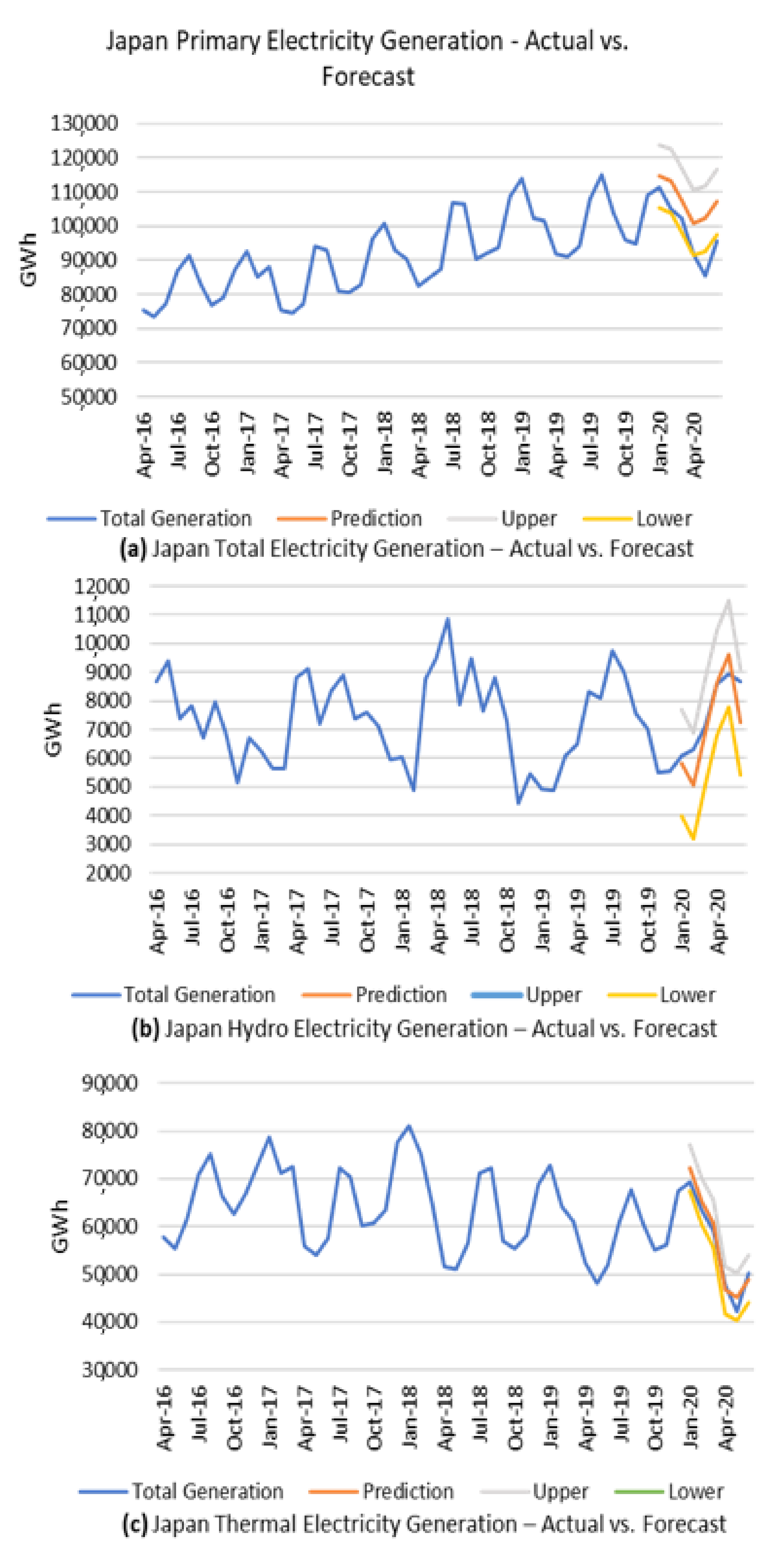
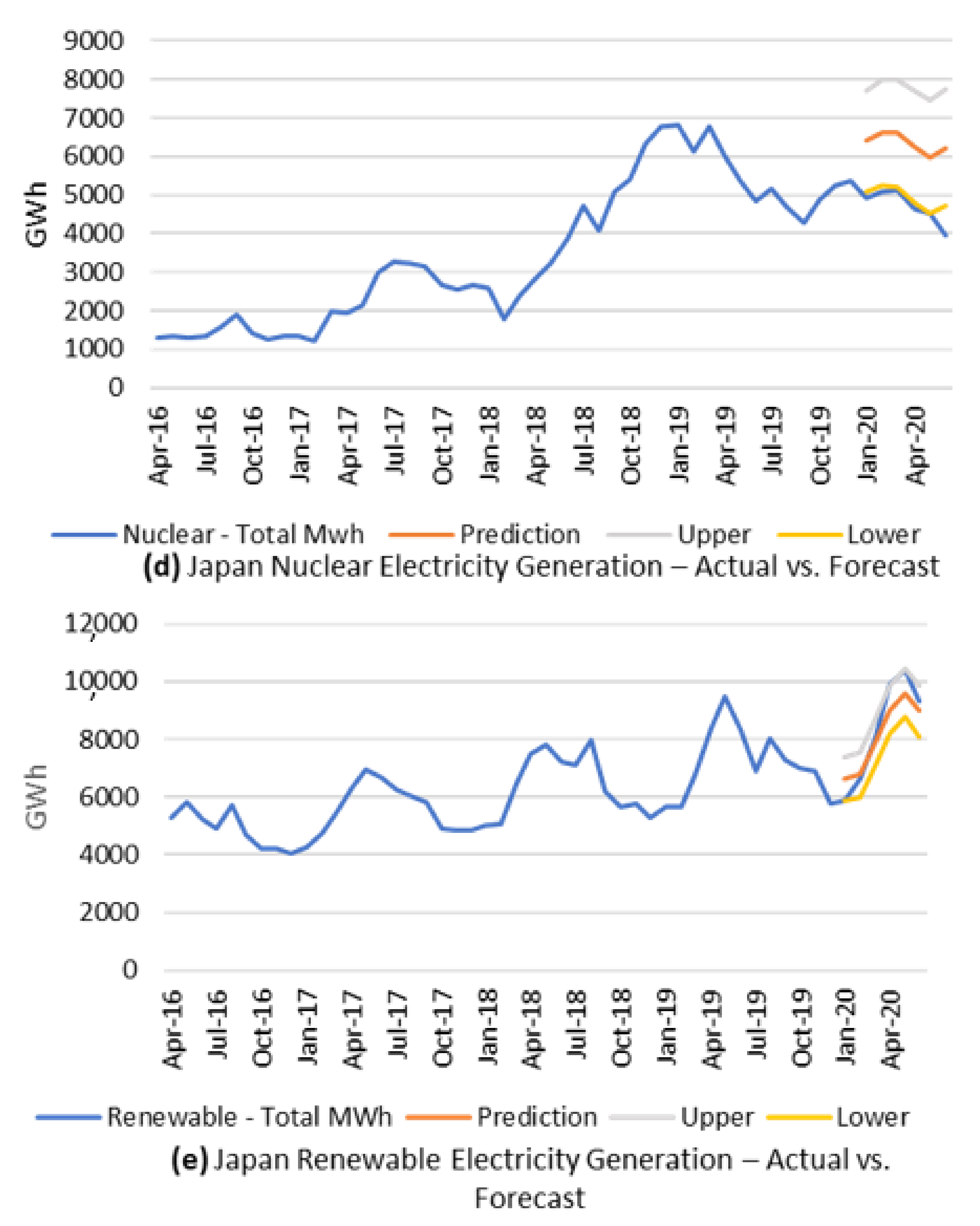
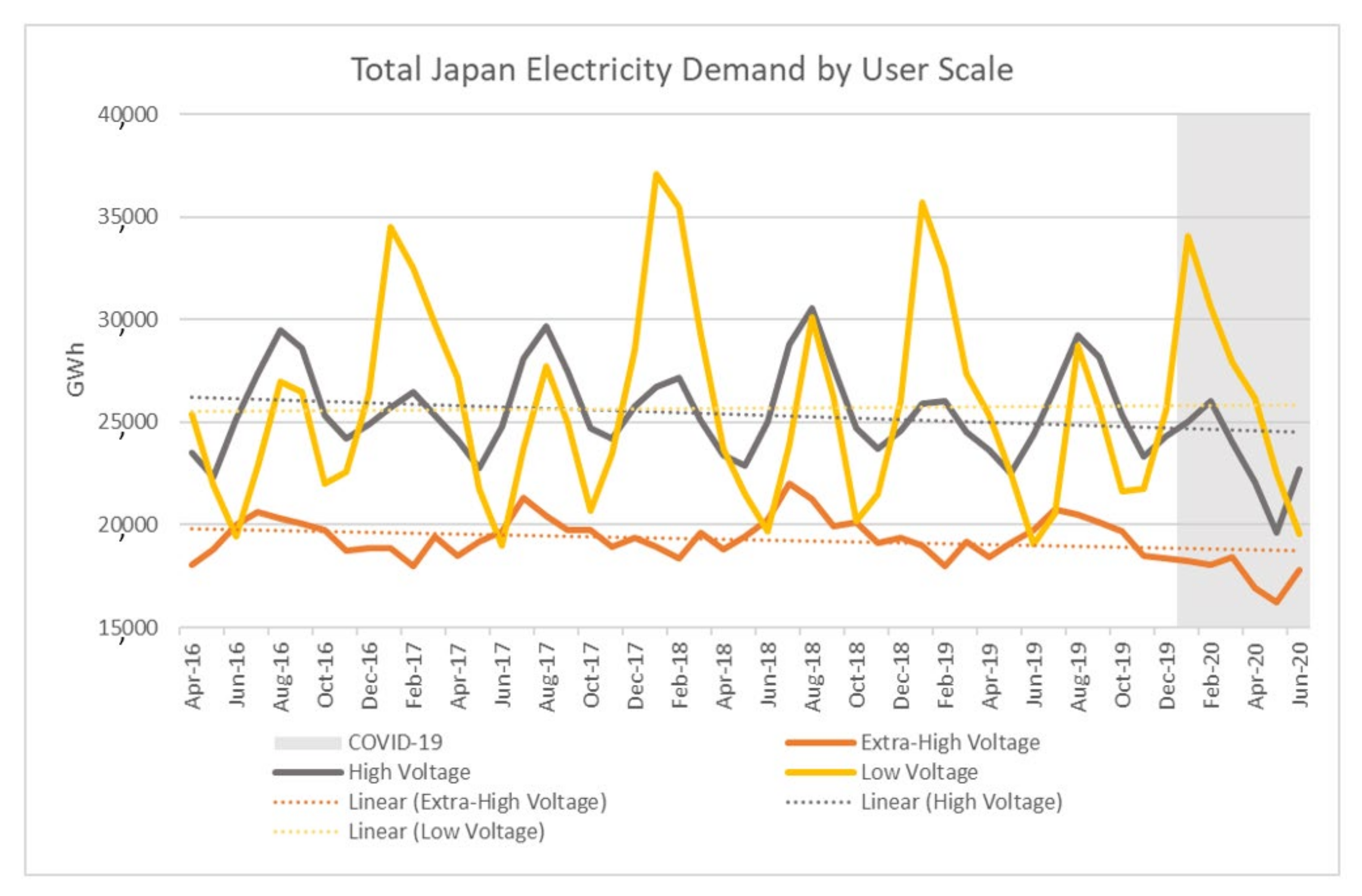
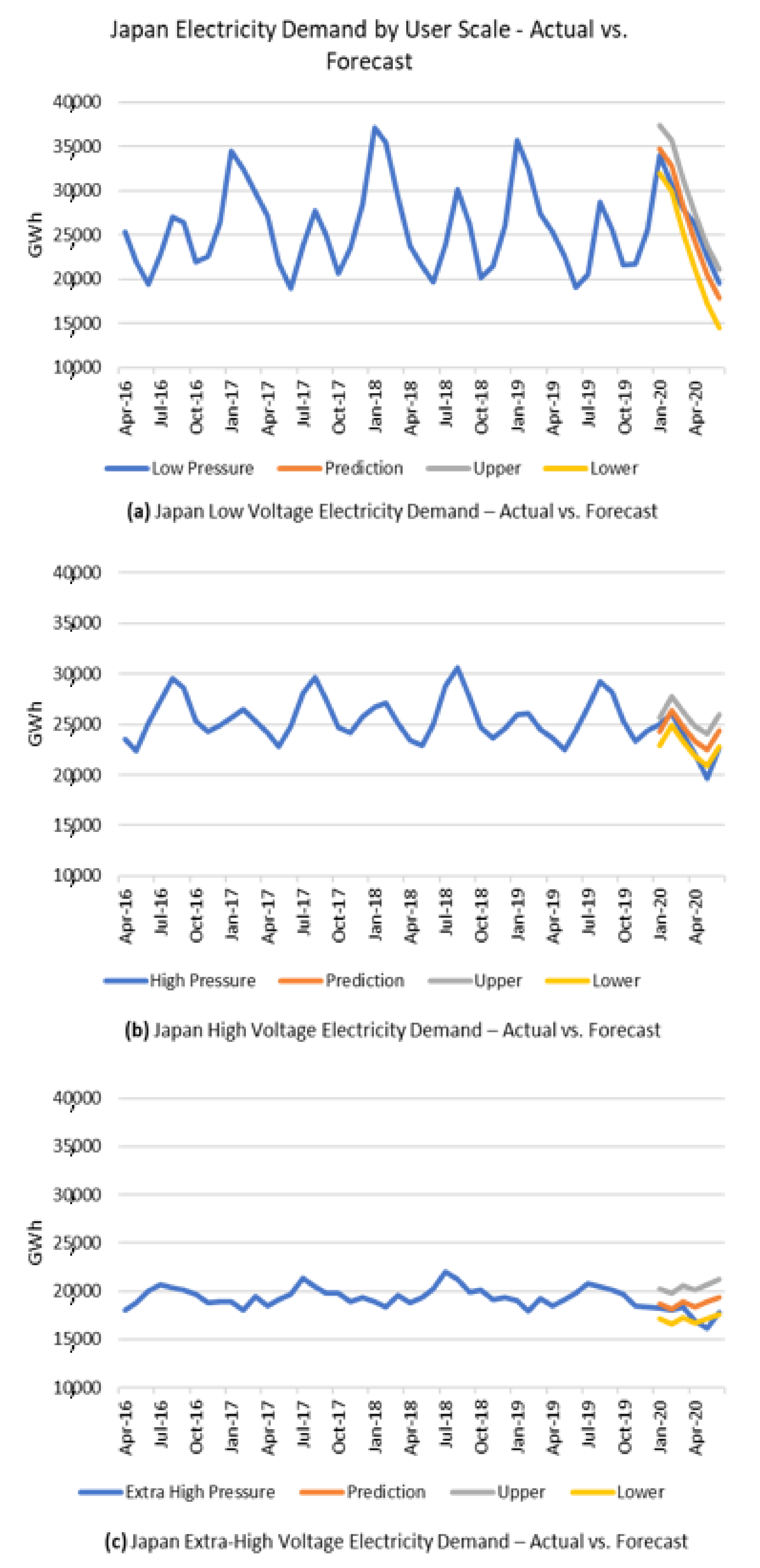
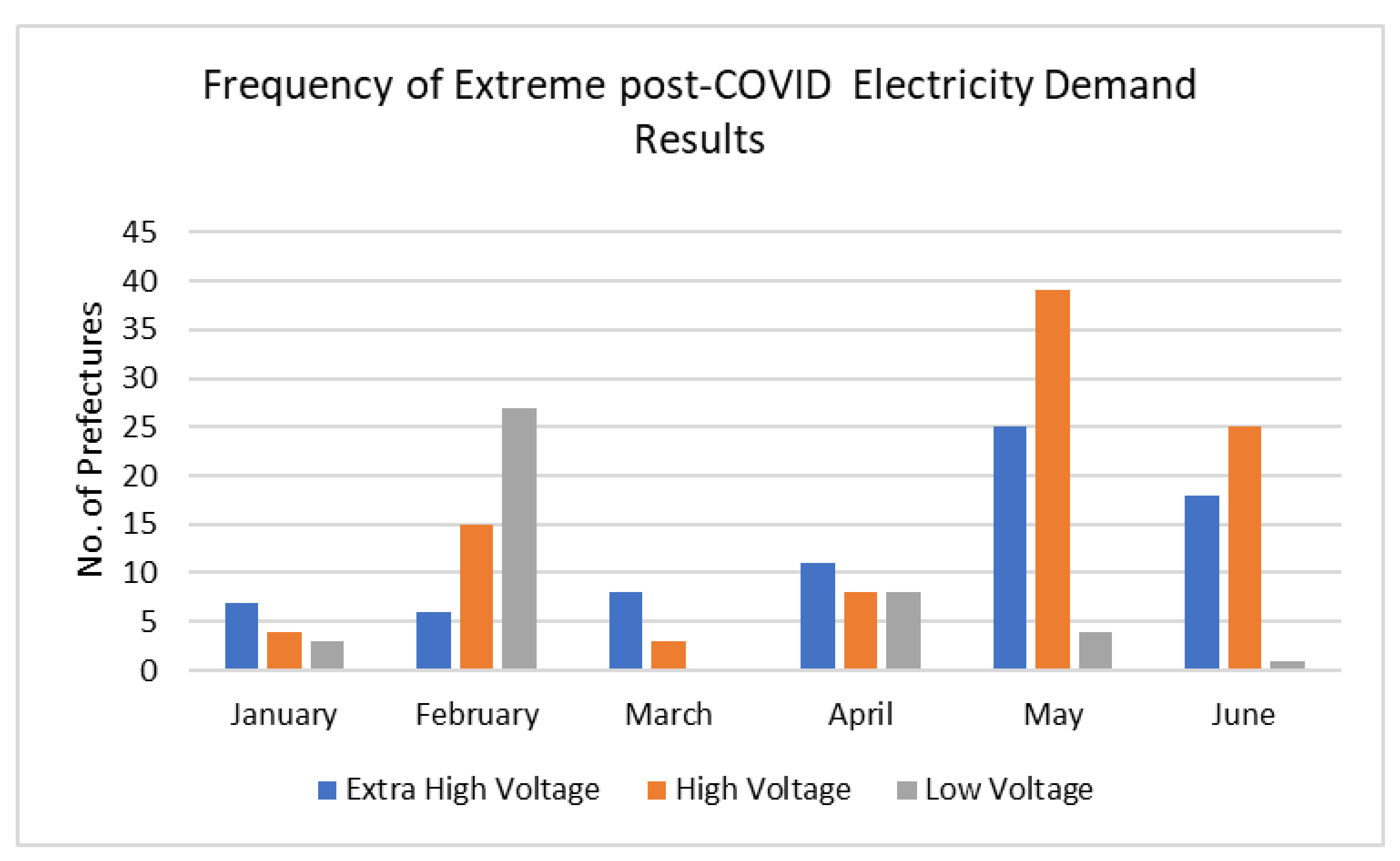
Publisher’s Note: MDPI stays neutral with regard to jurisdictional claims in published maps and institutional affiliations. |
© 2021 by the authors. Licensee MDPI, Basel, Switzerland. This article is an open access article distributed under the terms and conditions of the Creative Commons Attribution (CC BY) license (https://creativecommons.org/licenses/by/4.0/).
Share and Cite
D’Alessandro, K.; Chapman, A.; Dargusch, P. The Impact of COVID-19 on Electricity Demand and Generation in Japan. Sustainability 2021, 13, 10836. https://doi.org/10.3390/su131910836
D’Alessandro K, Chapman A, Dargusch P. The Impact of COVID-19 on Electricity Demand and Generation in Japan. Sustainability. 2021; 13(19):10836. https://doi.org/10.3390/su131910836
Chicago/Turabian StyleD’Alessandro, Kelly, Andrew Chapman, and Paul Dargusch. 2021. "The Impact of COVID-19 on Electricity Demand and Generation in Japan" Sustainability 13, no. 19: 10836. https://doi.org/10.3390/su131910836
APA StyleD’Alessandro, K., Chapman, A., & Dargusch, P. (2021). The Impact of COVID-19 on Electricity Demand and Generation in Japan. Sustainability, 13(19), 10836. https://doi.org/10.3390/su131910836








